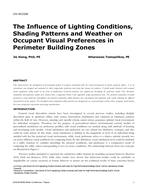Description
This study presents the development of personalized models of occupant satisfaction with the visual environment in private perimeter offices. A set of experiments was designed and conducted to collect comparative preference data from four human test-subjects. A probit model structure, with assumed latent satisfaction utility model in the form of multivariate Gaussian function, was adopted for developing the preference model. Four distinctive satisfaction and preference models were trained with a sequential Monte Carlo algorithm using experimental data. The posterior estimations of model parameters, visual preference probabilities and inferred satisfaction utility functions were investigated and compared, with results reflecting the different characteristics of the subjects. The developed visual satisfaction utility function was designed for use in personalized control, where occupants could balance their own satisfaction expectation and energy considerations.
Citation: 2018 Winter Conference, Chicago, IL, Conference Papers
Product Details
- Published:
- 2018
- Number of Pages:
- 9
- Units of Measure:
- Dual
- File Size:
- 1 file , 2.7 MB
- Product Code(s):
- D-CH-18-C036




